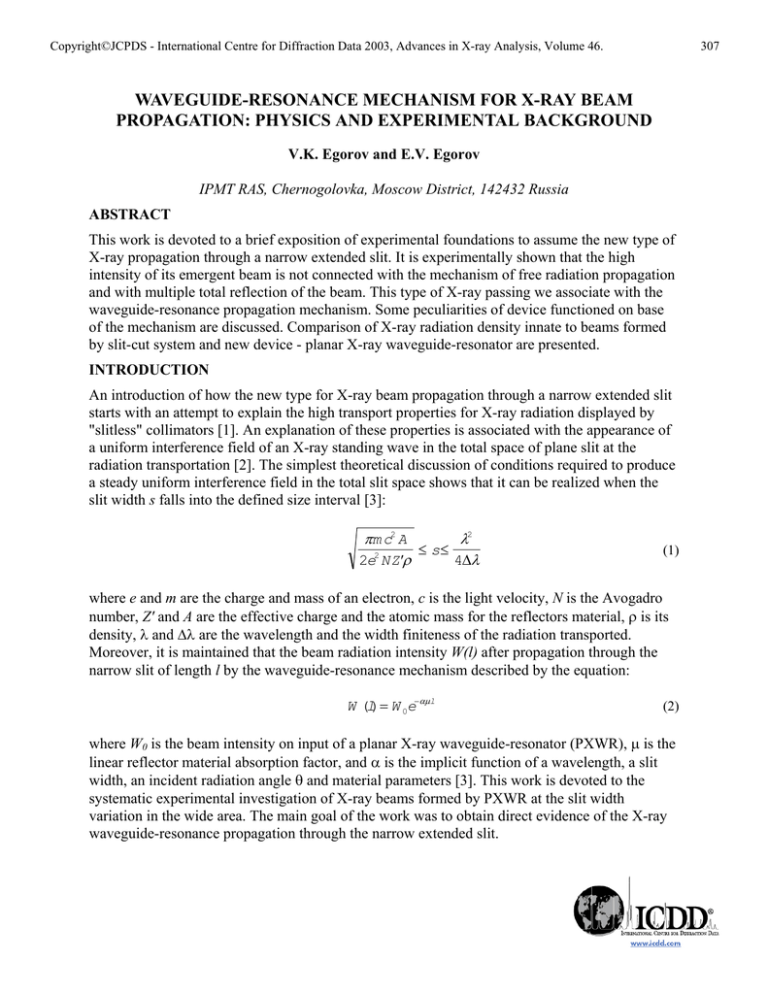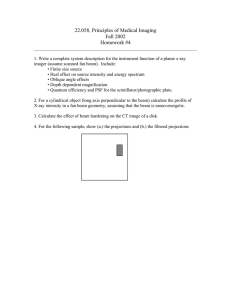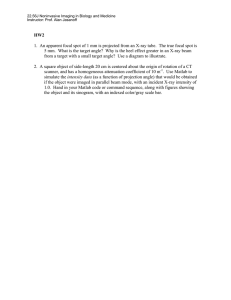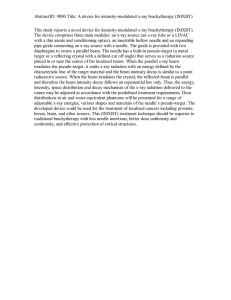waveguide-resonance mechanism for x-ray beam propagation
advertisement

Copyright©JCPDS - International Centre for Diffraction Data 2003, Advances in X-ray Analysis, Volume 46. 307 WAVEGUIDE-RESONANCE MECHANISM FOR X-RAY BEAM PROPAGATION: PHYSICS AND EXPERIMENTAL BACKGROUND V.K. Egorov and E.V. Egorov IPMT RAS, Chernogolovka, Moscow District, 142432 Russia ABSTRACT This work is devoted to a brief exposition of experimental foundations to assume the new type of X-ray propagation through a narrow extended slit. It is experimentally shown that the high intensity of its emergent beam is not connected with the mechanism of free radiation propagation and with multiple total reflection of the beam. This type of X-ray passing we associate with the waveguide-resonance propagation mechanism. Some peculiarities of device functioned on base of the mechanism are discussed. Comparison of X-ray radiation density innate to beams formed by slit-cut system and new device - planar X-ray waveguide-resonator are presented. INTRODUCTION An introduction of how the new type for X-ray beam propagation through a narrow extended slit starts with an attempt to explain the high transport properties for X-ray radiation displayed by "slitless" collimators [1]. An explanation of these properties is associated with the appearance of a uniform interference field of an X-ray standing wave in the total space of plane slit at the radiation transportation [2]. The simplest theoretical discussion of conditions required to produce a steady uniform interference field in the total slit space shows that it can be realized when the slit width s falls into the defined size interval [3]: πm c2 A λ2 ≤ s ≤ 2e2 NZ ′ρ 4∆λ (1) where e and m are the charge and mass of an electron, c is the light velocity, N is the Avogadro number, Z' and A are the effective charge and the atomic mass for the reflectors material, ρ is its density, λ and ∆λ are the wavelength and the width finiteness of the radiation transported. Moreover, it is maintained that the beam radiation intensity W(l) after propagation through the narrow slit of length l by the waveguide-resonance mechanism described by the equation: W ()= l W 0e−αµl (2) where W0 is the beam intensity on input of a planar X-ray waveguide-resonator (PXWR), µ is the linear reflector material absorption factor, and α is the implicit function of a wavelength, a slit width, an incident radiation angle θ and material parameters [3]. This work is devoted to the systematic experimental investigation of X-ray beams formed by PXWR at the slit width variation in the wide area. The main goal of the work was to obtain direct evidence of the X-ray waveguide-resonance propagation through the narrow extended slit. This document was presented at the Denver X-ray Conference (DXC) on Applications of X-ray Analysis. Sponsored by the International Centre for Diffraction Data (ICDD). This document is provided by ICDD in cooperation with the authors and presenters of the DXC for the express purpose of educating the scientific community. All copyrights for the document are retained by ICDD. Usage is restricted for the purposes of education and scientific research. DXC Website – www.dxcicdd.com ICDD Website - www.icdd.com Copyright©JCPDS - International Centre for Diffraction Data 2003, Advances in X-ray Analysis, Volume 46. EXPERIMENTAL SETUP FOR RADIATION DENSITY STUDY IN X-RAY BEAMS The X-ray radiation intensity distribution study was done with a diffractometer HZG-4 with a detector circle radius increasing up to 500 mm. The diffractometer permits one to carry out continuous and step by step scanning with a minimum step size δ(2θ)=0.001°. The width and height of the detector slit were 0.1 mm and 10 mm, respectively. X-ray slit-cut forming system and the detector unit were equipped with Soller slits of 2° angular divergence. X-ray source was a BSW-24 with a stationary Cu anode. The geometrical size of anode was 1×10 mm2. The takeoff angle was near 6°. Main experiments were carried out at tube parameters U=20 keV, I=10 mA. Radiation intensity distribution data were collected with Cu film attenuator (A). Electronics were NIM standard modules from Ortec. Amplifier shaping time was selected to be equal to 0.5 µs. The registration system was able to collect the information at the count rate up to 100 kHz. EXPERIMENTAL MEASUREMENTS OF BEAMS AFTER SLIT-CUT FORMER Experimental investigations of beams formed by slit-cut systems allow one to evaluate properties of the X-ray source and to define the magnitude of the transmitted X-ray beam characterized by parallel (or quasi-parallel) propagation of a radiation flow. X-ray source characteristics can be studied by application of the slit-cut system with a single slit (figure 1a). Properties of the quasi-parallel radiation flow are tested by using of the double slit-cut geometry (figure 1b). Since data of the parallel radiation intensity flow are needed for interpretation of results obtained for X-ray beams formed by planar X-ray waveguides (PXW), the distance between slits in geometry "b" was equal to the waveguides length l12=100 mm. Diagrams in bottom of Figure 1 display four CuKα radiation distributions corresponding to the different slit size for single slit-cut forming geometry and the distribution for the double slit-cut formation. The single slit-cut former creates high intensity beams with a significant divergence. Such beams are usually used with Bragg-Brentano geometry [4]. Distributions allow to evaluate total intensities and average radiation densities in beams. Moreover, our experiments found that the tube focus consisted of two active zones. Total Figure 1. Experimental geometries of single intensity of the beam after double slit-cut system must (a) and double (b) slit-cut systems for X-ray be equivalent to that of the beam propagated through the beam formation and intensity distributions (c) narrow extended slit with the same width. This value in beams after single slit (1 - S1=0.5 mm; 2 S1=0.25 mm; 3 - S1=0.15 mm; 4 - S1=0.1 mm) reflects the intensity of the direct X-ray beam passed and (5) double slit S1=S3=0.1 mm. l1=75 mm, through the waveguide slit without interaction with l12=100 mm, l2=160 mm, l4=60 mm, l3=400 reflector surfaces. mm, S2=0.1 mm. Tube (Cu) regime U=20 keV, I=10 mA. A - attenuator (factor K=200). 308 Copyright©JCPDS - International Centre for Diffraction Data 2003, Advances in X-ray Analysis, Volume 46. WAVEGUIDE UNITS PREPARATION Reflectors for PXW studied in the work were prepared by using plane polished amorphous quartz glass plates 100×33×2.5 mm. Two reflectors were placed with a fixed distance between them, and the distance was defined by using metallic strips deposited on the edges of one reflector. The deposit thickness was controlled by RBS method. The thickness variation along the entire reflector length (l=100 mm) did not exceed 1%. The thickness of the strips defined the waveguide air slit width. Height of the slits was 10 mm. Reflector pairs were mounted in a duralumin holder and were placed on the horizontal diffractometer HZG-4 instead of a cut-slit system for the X-ray beam forming as similar as the setup used in previous works [3,5-7]. Four microscrews located near the waveguide reflector corner positions enabled the operator to align waveguides during the diffractometer arrangement. They ensure one translational and two angle degrees of freedom for the holder. Microscrews and springs were used to fix of the PXW position. Figure 2 shows the schematic design of the waveguide used to study the X-ray propagation through a Figure 2. Schematic design of the air slit narrow extended slit. PXW fabrication. RADIATION INTENSITY DISTRIBUTION IN XRAY BEAMS Figure 3a shows the geometry scheme for the study of the X-ray radiation intensity distribution in beams formed by PXW. The waveguides position in the scheme was not changed during all measurements. The distance between detector slit and waveguide outlet was equal to 460 mm and the distance between the focal spot and waveguide inlet was 75 mm. The angle width of the detector slit was approximately half that used in the Xray beam scanning experiments and was equal to 0.01°. Because of this, total intensities of peaks shown on Figure 3b can be doubled by increasing the total sum of peak channel's contents. The single channel analyzer, during all experiments, transmitted pulses connected with the copper characteristic radiation, only. PXW whose experimental distributions shown in Figure 3b had the slit sizes s=43 nm, 88 nm, 105 nm, 209 nm, 410 nm, 800 nm, 2000 nm, 3000 nm, 10000 nm, 60000 nm, 120000 nm. Moreover, the distribution in the beam after slitless collimator is presented as well. The width evaluation of this slit was the specific experimental task. It was studied by means of the Attenuated Internal Total Reflection Method [8] along all its length by using optical radiation with a wavelength λ=640 nm. These Figure 3. Measurement geometry (a) and intensity distributions for PXW with variable slit width (b). l1=75 mm, lPXW=100 mm, l2=60 mm, l3=400 mm, S2=0.1 mm. Tube (Cu) regime U=20 keV, I=10 mA. A - attenuator (factor K=200). 309 Copyright©JCPDS - International Centre for Diffraction Data 2003, Advances in X-ray Analysis, Volume 46. measurements showed that the slit size varied within the interval 0÷60 nm with an average value of 30 nm. The intensity distribution of an X-ray beam formed by PXW does not undergo serious transformation within the slit size interval 0≤s≤2 mkm. Peak of the distributions has an almost Gaussian profile with some FWHM and intensity variations. When slit size is increased, the peak shape assumes a new configuration, and the profile contains a set of lines. As a first approximation, the experimental dependence of the X-ray beam total intensity on slit size shown in Figure 4 can be presented by three typical intervals: s≤200 nm, 200≤s≤3000 nm and s≥3 mkm. If we assume that the waveguide emergent beam contains some independent power deposits, one of them - the direct beam generated by X-ray tube must pass through the waveguide slit without interacting with the reflector's surface at any slit size. At the perfect alignment of X-ray optical system the direct beam must form a peak at the zero angle detector position and must be characterized by linear dependence of intensity on slit size, and zero intensity at zero slit width. Experimental data presented in Figure 4 shows that a similar dependence type in the pure state is not observed. Total intensity of X-ray beam formed by a planar waveguide is approximately constant Figure 4. (a) Experimental dependence of X-ray total intensity on slit width for the beam formed by within a slit width interval 0≤s≤200 nm. The direct PXW, and (b) the intensity expected for the beam beam intensity is not higher 1% from the propagated through waveguide by free manner. experimental value of the beam total intensity for this slit width range. The intensity begins to increase linearly with the further slit size enhancement, owing to the fact that the direct beam contribution achieves a visible magnitude in a total X-ray beam intensity for the area s≥200 nm. When the slit size reaches the value s≈3 mkm, additional independent contributions from the X-ray total reflection beams on both reflectors appear. The macroslit size area (s>3 mkm) is characterized by an independent rise of intensities of the direct beam and total reflection beams until the beam width achieves the size of an anode spot projection. Data obtained agrees with the next principal interpretation. PXW with a small slit size is distinguished by the resonance (or quasi-resonance) manner of X-ray radiation transportation and such waveguides we call planar X-ray waveguide-resonators (PXWR). An X-ray beam formed by PXWR constitutes an indivisible ensemble. The problem of the mode structure of such ensemble is not clear today [3], but in our opinion the resonance X-ray beam propagation is characterized by a continuous mode structure. The waveguide-resonance mechanism of X-ray radiation transportation by a narrow extended slit produces a high radiation density in the beam and minimizes irrevocable losses. The input angle aperture of PXWR is the same as the output one, and they can not exceed the value of a double total reflection critical angle [2]. Intermediate size interval (0.2≤s≤3 mkm) is characterized by two independent deposits (direct and quasi-resonance propagating beams). It is featured by an increase of a total X-ray beam 310 Copyright©JCPDS - International Centre for Diffraction Data 2003, Advances in X-ray Analysis, Volume 46. intensity as the waveguide slit enhances in size and, at the same time, by a decrease of X-ray radiation density in the beam. Input and output angle apertures remain constant. The interval shows the absence of individual deposits related to the total X-ray reflection phenomenon in spectra (Figure 3b). These deposits appear in area s≥3 mkm, and the output angle aperture begins enhance up to ∆θ=2θc at s≈6 mkm independently from the input aperture value. On further increasing of the slit width the intensity distribution shows multiple peaks. Since the anode of our tube had two separate active areas, the peak component quantity was equal to six. These components consist of two direct beam portion and four peaks associated with the total reflection on reflectors. This slit size area is characterized by free flowing and multiple consequence reflection mechanisms of X-ray propagation through a slit. It was very interesting to carry out the direct experimental comparison of X-ray radiation density magnitudes in beams formed by PXW and a conventional single slit forming system. Integrated intensities for distributions after slit-cut system are significantly higher in comparison with ones for distributions responsed to waveguide forming beams at the same X-ray source regime. But the waveguide beam formation is victorious in a radiation density parameter. Figure 5 shows that the radiation density in beams formed by PXW is considerably greater than the radiation density measured in beams after slit-cut system. It is connected with the radiation capture by PXW in the angle interval ∆ϕ≤2θc into the narrow waveguide slit. The direct comparison shows that the Figure 5. Experimental dependence of the radiation density for beams in the slit size interval average radiation density for CuKα radiation s≤200 nm is approximately 1000 times higher than the after PXW (a) and a single slit-cut system (b) density in beams formed by a conventional system. The on slit size. Data conform to the waveguide outlet space position. high efficiency of PXWR is the result of the X-ray standing wave interference field over the entire area of the slit and volumes of reflectors. 311 Copyright©JCPDS - International Centre for Diffraction Data 2003, Advances in X-ray Analysis, Volume 46. 312 SOME PECULIARITIES OF PXWR A major peculiarity of the simple PXWR is it's ability to serve as a threshold filter. Any radiation is characterized by the wavelength and the length of coherence. In line with the equation (1), the waveguide-resonance propagation of radiation will be realized up to its upper size limit λ2/(4∆λ). Higher energy radiation with a similar coherence length is not transported in a waveguide-resonance fashion and its attenuation will be significant. Figure 6 shows the experimental proof of this. It is a diffractometer pattern of a SiO2 [101] monocrystal equals the dispersion energy spectrum of an X-ray beam formed by PXWR. Coherence lengths of white and characteristic radiation generated by X-ray tube are approximately equal [9]. The concept of the standing wave interference field formation in a PXWR clearance asserts that the slit size Figure 6. Dispersion energy spectrum of the s=88 nm assists to the field arising for the X-ray energy beam after PXWR s=88 nm, l=100 mm, l1=75 region E<9 keV. Copper characteristic radiation passes mm, l2=60 mm, l3=160 mm, S2=0.1 mm. Tube through the slit without attenuation, but short (Cu) regime U=40 keV, I=10 mA. wavelength X-ray radiation intensity is very low in the spectrum of the PXWR emergent beam. The peak in the high energy area can be explained by the fact that absorption decreases as the energy of the beam increases. PXWR concentrates the radiation by it's capture over the angular interval ϕ1≤2θc. The divergence of the emergent beam is equal of its capture angle. The width of beam after PXWR is near 100 nm. The roughness of reflector surfaces must be not exceed the critical size of microunevenness hc [10]: 1 πm c2 A hc ≤ 8 e2 NZ ′ρ (3) hc magnitude is near 5 nm. Reflectors used in PXWR must be characterized by dielectric properties. The surface flatness of reflectors is very important for the arising of a uniform interference field in the slit space. Integrated intensity and divergence of the PXWR emergent beam will increase as the density of material reflector enhances. CONCLUSION Discovery of the waveguide-resonance manner for X-ray radiation propagation opens a new page in X-ray optics and optics of other radiation. The radiation density in beams after waveguideresonators is higher in comparison with other former devices. The width of beam is characterized by an unique small size. However, the important dignity of PXWR is the fact of the ability existence to modify the X-ray beam by influence on the standing wave interference field in the Copyright©JCPDS - International Centre for Diffraction Data 2003, Advances in X-ray Analysis, Volume 46. waveguide slit [11]. Possible practical applications of PXWR for TXRF and diffractometry were presented in earlier works [3,5]. The work was carried out at the partial support of Russian Foundation for Fundamental Research (projects #01-03-33167, #02-02-2209). REFERENCES [1] Egorov, V.; Kondratiev, O.; Zuev, A.; Egorov. E., Advances in X-ray Analysis, 2000, 43, 406-417. [2] Egorov, V.; Egorov, E., Los Alamos e-print archive. 2001. http://arxiv.org/list/physics.insdet/recent/#0101059. [3] Egorov, V.; Egorov, E.; Bil'chik, T., Investigation in Russia, 2002, 3, 423-441. http://zhurnal.ape.relarn.ru/articles/2002/040e.pdf [4] Klug, H.; Alexander, L., X-ray Diffraction Procedure, Wiley: New York, 1973, 669. [5] Egorov, V.; Egorov, E., Thin Solid Films, 2001, 398-399, 405-412. [6] Egorov, V.; Egorov, E., Proceeding of SPIE, 2001, 4502, 148-172. [7] Egorov, V.; Egorov, E., Proceeding of SPIE, 2002, 4765 (in publication). [8] Harrick, N., Internal Reflection Spectrometry, Wiley: New York, 1967, 282. [9] Klockenkamper R., Total Reflection X-ray Fluorescence Analysis, Wiley: New York, 1997. [10] Blochin, M., Physik der Runtgenstrahlen. Verlag der Technik: Berlin, 1957, 535. [11] Egorov, V.; Egorov, E., Proceedings of MRS, 2002, 716, 189-195. 313






